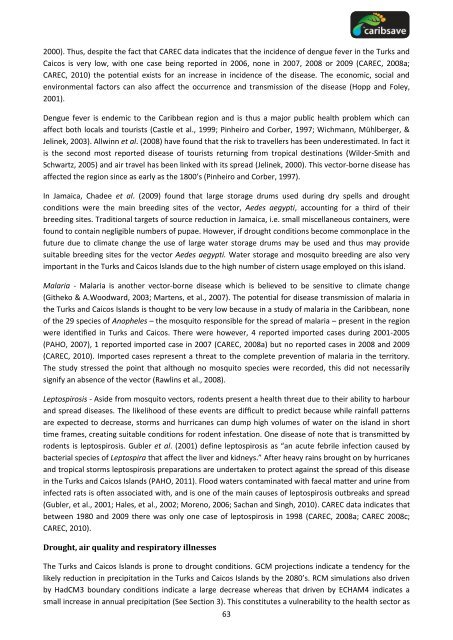You also want an ePaper? Increase the reach of your titles
YUMPU automatically turns print PDFs into web optimized ePapers that Google loves.
2000). Thus, despite the fact that CAREC data indicates that the incidence of dengue fever in the <strong>Turks</strong> <strong>and</strong><br />
<strong>Caicos</strong> is very low, with one case being reported in 2006, none in 2007, 2008 or 2009 (CAREC, 2008a;<br />
CAREC, 2010) the potential exists for an increase in incidence of the disease. The economic, social <strong>and</strong><br />
environmental factors can also affect the occurrence <strong>and</strong> transmission of the disease (Hopp <strong>and</strong> Foley,<br />
2001).<br />
Dengue fever is endemic to the Caribbean region <strong>and</strong> is thus a major public health problem which can<br />
affect both locals <strong>and</strong> tourists (Castle et al., 1999; Pinheiro <strong>and</strong> Corber, 1997; Wichmann, Mühlberger, &<br />
Jelinek, 2003). Allwinn et al. (2008) have found that the risk to travellers has been underestimated. In fact it<br />
is the second most reported disease of tourists returning from tropical destinations (Wilder-Smith <strong>and</strong><br />
Schwartz, 2005) <strong>and</strong> air travel has been linked with its spread (Jelinek, 2000). This vector-borne disease has<br />
affected the region since as early as the 1800’s (Pinheiro <strong>and</strong> Corber, 1997).<br />
In Jamaica, Chadee et al. (2009) found that large storage drums used during dry spells <strong>and</strong> drought<br />
conditions were the main breeding sites of the vector, Aedes aegypti, accounting for a third of their<br />
breeding sites. Traditional targets of source reduction in Jamaica, i.e. small miscellaneous containers, were<br />
found to contain negligible numbers of pupae. However, if drought conditions become commonplace in the<br />
future due to climate change the use of large water storage drums may be used <strong>and</strong> thus may provide<br />
suitable breeding sites for the vector Aedes aegypti. Water storage <strong>and</strong> mosquito breeding are also very<br />
important in the <strong>Turks</strong> <strong>and</strong> <strong>Caicos</strong> Isl<strong>and</strong>s due to the high number of cistern usage employed on this isl<strong>and</strong>.<br />
Malaria - Malaria is another vector-borne disease which is believed to be sensitive to climate change<br />
(Githeko & A.Woodward, 2003; Martens, et al., 2007). The potential for disease transmission of malaria in<br />
the <strong>Turks</strong> <strong>and</strong> <strong>Caicos</strong> Isl<strong>and</strong>s is thought to be very low because in a study of malaria in the Caribbean, none<br />
of the 29 species of Anopheles – the mosquito responsible for the spread of malaria – present in the region<br />
were identified in <strong>Turks</strong> <strong>and</strong> <strong>Caicos</strong>. There were however, 4 reported imported cases during 2001-2005<br />
(PAHO, 2007), 1 reported imported case in 2007 (CAREC, 2008a) but no reported cases in 2008 <strong>and</strong> 2009<br />
(CAREC, 2010). Imported cases represent a threat to the complete prevention of malaria in the territory.<br />
The study stressed the point that although no mosquito species were recorded, this did not necessarily<br />
signify an absence of the vector (Rawlins et al., 2008).<br />
Leptospirosis - Aside from mosquito vectors, rodents present a health threat due to their ability to harbour<br />
<strong>and</strong> spread diseases. The likelihood of these events are difficult to predict because while rainfall patterns<br />
are expected to decrease, storms <strong>and</strong> hurricanes can dump high volumes of water on the isl<strong>and</strong> in short<br />
time frames, creating suitable conditions for rodent infestation. One disease of note that is transmitted by<br />
rodents is leptospirosis. Gubler et al. (2001) define leptospirosis as “an acute febrile infection caused by<br />
bacterial species of Leptospira that affect the liver <strong>and</strong> kidneys.” After heavy rains brought on by hurricanes<br />
<strong>and</strong> tropical storms leptospirosis preparations are undertaken to protect against the spread of this disease<br />
in the <strong>Turks</strong> <strong>and</strong> <strong>Caicos</strong> Isl<strong>and</strong>s (PAHO, 2011). Flood waters contaminated with faecal matter <strong>and</strong> urine from<br />
infected rats is often associated with, <strong>and</strong> is one of the main causes of leptospirosis outbreaks <strong>and</strong> spread<br />
(Gubler, et al., 2001; Hales, et al., 2002; Moreno, 2006; Sachan <strong>and</strong> Singh, 2010). CAREC data indicates that<br />
between 1980 <strong>and</strong> 2009 there was only one case of leptospirosis in 1998 (CAREC, 2008a; CAREC 2008c;<br />
CAREC, 2010).<br />
Drought, air quality <strong>and</strong> respiratory illnesses<br />
The <strong>Turks</strong> <strong>and</strong> <strong>Caicos</strong> Isl<strong>and</strong>s is prone to drought conditions. GCM projections indicate a tendency for the<br />
likely reduction in precipitation in the <strong>Turks</strong> <strong>and</strong> <strong>Caicos</strong> Isl<strong>and</strong>s by the 2080’s. RCM simulations also driven<br />
by HadCM3 boundary conditions indicate a large decrease whereas that driven by ECHAM4 indicates a<br />
small increase in annual precipitation (See Section 3). This constitutes a vulnerability to the health sector as<br />
63





